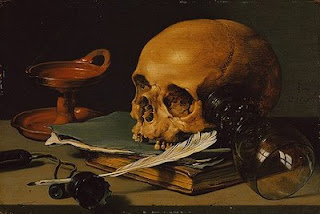The 17th Century was a time of war, plaque and religious persecution. The Roman Catholic church played a big roll on how most painting were painted. Most had representational religious backgrounds. It was suppose to express power, seriousness and control. The representational religious themed backgrounds were very dark. The roman catholic church encouraged these type of paintings. Then there where still life which was a phenomenon for artist to carefully observe and record the everyday stuff. Even though the religious painting were suppose to make your faith stronger, the backgrounds were still dark and to me kind of contradicted the subject. For me Pieter Claesz still life paintings fit the background to it’s true self. Some of his still life painting represented death. When you think of death you think of darkness.
In Pieter Claesz still life with a skull and a writing quill, the monochromatic scheme really works with the back ground and the still life that were use like the skull, were very successful in portraying the message he was try to tell. This painting represents a passage of time or a present that is no longer here. The same with the Vanitas still life with the spinaro. It also represents the passage of time.

 The still life with turkey pie really speaks to me it’s a beautiful arrangement of food. The light bounces off the monochromatic background which gives the food a more realistic look. Since I have issues with food this painting really speaks to me. It’s says to me it’s “good but it can kill you too.” I know most would not get that out of this painting but I guess my mind work differently.
The still life with turkey pie really speaks to me it’s a beautiful arrangement of food. The light bounces off the monochromatic background which gives the food a more realistic look. Since I have issues with food this painting really speaks to me. It’s says to me it’s “good but it can kill you too.” I know most would not get that out of this painting but I guess my mind work differently. Source: Keiner, Fred. Gardner’s Art though the ages.Boston ,MA: Baxker, 2009, page 690
